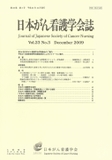Japanese
English
- 販売していません
- Abstract 文献概要
- 参考文献 Reference
- サイト内被引用 Cited by
要旨
本研究の目的は,在宅で終末期がん患者と共に生活する主たる介護者の生活の様相を明らかにすることである.研究対象者は在宅で終末期がん患者と共に生活する主たる介護者6名であった.データ収集は,半構成面接法にて行い,質的帰納的に分析を行った.その結果,【患者と生活することでの体験】は,《患者の心身の状況に左右される生活》,《拘束感を感じながらの生活》,《限られた命を意識しながらの生活》,《予測が立たないなかでの生活》の4カテゴリーが抽出された.【家族の力で介護できる方策を創り出す】は,《自分の体調を気遣う》,《介護のコツを覚える》,《家族員が協力しあう》,《周囲のサポートを得ながら介護を行う》,《他の家族の頑張りを自分たち家族の力にする》,《家族がくつろげる場を創り出す》,《よりどころを持ちながら患者との生活を充実させる》の7カテゴリーが抽出された.在宅で終末期がん患者と生活する家族の体験を理解し,家族の力で介護できるように支援していくことが重要である.
Abstract
The purpose of this study was to describe aspects of family life when a family caregiver who lives at home has terminal stage cancer. A convenience sample of human subjects informed participants, was six families with a member living at home in the terminal stage of cancer. Taped and transcribed interviews provided data, which was qualitatively analyzed. Results revealed two main themes. The first theme was 'the experience of living with the patient'. The four categories were extracted: life became controlled by the patient's state of the mind and body; family members developed a feeling of restriction in their life; family became conscious of limited life; life became unpredictable. The second theme, 'creating family strategies of care for patient' contained seven extracted categories: caring for own physical condition; creating a comfortable environment for the family; learning to cooperate as a family; getting the 'knack of care-giving; receiving caring support from neighbors while creating family strength through the perseverance of other families and living to the fullest with the patient in the time remaining. This analysis suggests that family life with a terminally ill family member is complex. Understanding both how families respond and that they have potential for strength and caring will assist nurses in supporting families' care strategies for their terminally ill member at home.
Copyright © 2009, Japanese Society of Cancer Nursing All rights reserved.


